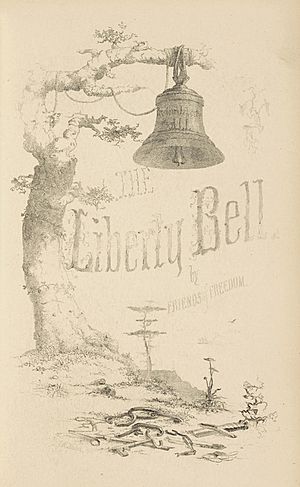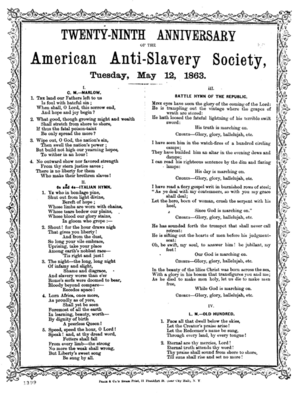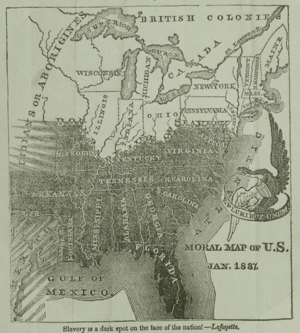American Anti-Slavery Society facts for kids
The American Anti-Slavery Society (AASS) was an important group that worked to end slavery in the United States. It was active from 1833 to 1870. William Lloyd Garrison and Arthur Tappan started the society.
Many famous people were part of this group. Frederick Douglass, who had escaped slavery, became a key leader and often spoke at meetings. William Wells Brown, another freedman, also spoke often. By 1838, the society had grown very large. It had 1,350 local groups and about 250,000 members.
Other well-known members included Susan B. Anthony, Elizabeth Cady Stanton, Lucretia Mott, and John Greenleaf Whittier. The society was based in New York City. From 1840 to 1870, they published a weekly newspaper called the National Anti-Slavery Standard.
Contents
- Why the Society Started
- About the Society
- The Constitution of the Society
- Preamble: Why the Society Existed
- Article I: The Name
- Article II: Ending Slavery
- Article III: Improving Lives
- Article IV: Membership Rules
- Article V: Leadership Roles
- Article VI: Annual Elections and Duties
- Article VII: Leaders' Responsibilities
- Article VIII: Meetings
- Article IX: Joining Forces
- Article X: Changing the Constitution
- Why the Organization Split
- End of the Society
- See also
Why the Society Started
In the 1820s, there were some quiet times regarding slavery. But by the end of the decade, new events brought the issue back into focus. People in Virginia had serious talks about ending slavery. In the North, some discussed freeing enslaved people and sending them to Africa. This idea led to the founding of Liberia by the American Colonization Society.
Things became more intense with new publications and events. David Walker published his Appeal to the Colored Citizens of the World in 1829. In 1831, Nat Turner's slave rebellion caused fear in the South. This rebellion involved enslaved and free Black people fighting for freedom. It led to stricter laws about enslaved people's behavior across the Southern states.
Also in 1831, the nullification crisis happened. South Carolina wanted to ignore a federal tax law. President Andrew Jackson said he would use the army to make sure federal laws were followed. This event made Southerners worry that the government might soon try to end slavery. These fears grew when the American Anti-Slavery Society was founded in 1833.
Before the AASS, the main anti-slavery group was the American Colonization Society. This group believed that Black and white people could not live together peacefully. They suggested sending former enslaved people to Africa. They even bought land there, which became Liberia.
The American Anti-Slavery Society formed to fight slavery based on moral and practical reasons. From December 4-6, 1833, sixty people from different states met in Philadelphia. They created the American Anti-Slavery Society Constitution and a Declaration of Sentiments. William Lloyd Garrison, who published Liberator newspaper, wrote most of these documents.
About the Society
Leaders of the Society
The first leaders of the American Anti-Slavery Society included Arthur Tappan as President. William Lloyd Garrison was one of the main founders. Three years before starting the Society, Garrison began publishing The Liberator. This newspaper called for the immediate freedom of all enslaved people. Its motto was: "Our country is the world - our countrymen are mankind."
In 1840, the Society faced a big disagreement. Some members did not like that Abby Kelley was appointed to a business committee. They also disagreed about including women's rights with the fight against slavery. Because of this, some leaders, including Arthur Tappan and his brother, left the AASS. They started a new group called the American and Foreign Anti-Slavery Society. Six African-American men also left. They were concerned about white women leading the movement.
Frederick Douglass joined the American Anti-Slavery Society after this split. He was very active in the Massachusetts Anti-Slavery Society from 1841-1842. He began speaking for the AASS in 1843. Douglass was born into slavery but escaped. He became a powerful speaker for the abolitionist movement. He also supported women's right to vote at the Seneca Falls Convention.
Francis Jackson was another president of the Society. He was the grandfather of Francis Jackson Meriam, who was involved in John Brown's raid.
Society's Activities
The American Anti-Slavery Society was often met with strong opposition. Its activities sometimes led to violence. Mobs would attack meetings, speakers, and even burn printing presses. By the mid-1830s, slavery was a huge part of the U.S. economy. Ending it would cause major changes. Enslaved labor produced a lot of wealth, especially from cotton, for both Southern plantation owners and Northern businesses.
In December 1833, abolitionists met in Philadelphia. There were 62 delegates, and 21 of them were Quakers. William Lloyd Garrison wrote the new declaration for the American Anti-Slavery Society. This document strongly condemned slavery. It called for slavery to end immediately without any conditions. It also criticized the American Colonization Society. The declaration stated that the group would be pacifist, meaning they would not use violence.
In July 1834, the society's goals were misunderstood. This led to the Farren Riots in New York. Homes and properties of abolitionists were attacked. After the riots, the society issued a public statement. They said they did not want to encourage marriages between white and Black people. They also said they would not encourage breaking laws or trying to end the Union. They promised to work for change peacefully.
Theodore S. Wright, a Black minister, was a key founding member. He served on the executive committee until 1840. Wright, along with leaders like Tappan and Garrison, worked for temperance, education, and voting rights for Black people.
Wright spoke about the unfair treatment Black people faced. He said, "No matter how we may act, we find difficulties everywhere." He also pointed out how prejudice kept Black people from religious activities. He questioned why Christians would spread the Bible overseas but treat Black people badly at home.
Many founders used practical reasons to argue against slavery. They said it did not make economic sense. Wright used religious arguments, saying slavery was a sin and asking for empathy for African Americans.
Frederick Douglass wrote letters to Garrison about the problems caused by slavery. He shared his own experiences with prejudice, especially in churches. He described how Black members were treated differently during communion. Douglass hoped his letters would remind Garrison why slavery must be ended.
In 1840, the American Anti-Slavery Society was invited to the World Anti-Slavery Convention in London, England. This meeting was for abolitionists from around the world. It aimed to strengthen their commitment to equality. However, female delegates were not allowed to participate. They could only watch from a special gallery.
This rule upset many. Lucretia Mott and Elizabeth Cady Stanton were two women who decided to form a group for women's rights because of this. When Garrison arrived late and heard about the rule, he chose not to enter the convention. He sat with the women in the gallery. This event helped start the women's suffrage movement, which fought for women's right to vote.
The Constitution of the Society
Preamble: Why the Society Existed
The preamble is like an introduction to the Society's main goals. It explains that the Society was created to free enslaved people. It emphasized using peaceful persuasion, not violence, to argue against slavery and unfair treatment of people of color.
Article I: The Name
Article I simply states, "The Society shall be called the American Anti-Slavery Society." This officially set the group's name.
Article II: Ending Slavery
Article II explains why slavery is wrong for everyone and in God's eyes. It says the Society would work in a legal way to convince Congress to end the slave trade within the country. It also aimed to end slavery in states and stop it from spreading to new states joining the Union.
Article III: Improving Lives
Article III describes how the group would help improve the lives of people of color. They would do this by encouraging education, good morals, and religious growth. This article recognized the prejudice and inequality faced by people of color. The Society hoped to gain equal civil and religious rights for them, but only through peaceful means.
Article IV: Membership Rules
Article IV lists what members needed to do. This included giving money to the society and following its rules. Members who followed these rules could vote within the society.
Article V: Leadership Roles
Article V clearly names the different leadership positions in the society. These included a President, Vice Presidents, Secretaries, a Treasurer, and a Board of Managers. It also stated that members would elect these leaders.
Article VI: Annual Elections and Duties
Article VI set up a plan for yearly elections for an executive committee. It explained how many people would be on this committee. It also listed the committee's jobs, such as making their own rules, filling empty positions, managing money, and calling special meetings.
Article VII: Leaders' Responsibilities
Article VII outlined the specific duties of the President, the secretaries, and the Treasurer of the society.
Article VIII: Meetings
Article VIII stated that the society would hold meetings every year. The executive committee was in charge of choosing the time and place for these meetings.
Article IX: Joining Forces
Article IX allowed other anti-slavery groups or associations that followed the same principles to join the American Anti-Slavery Society. These joining groups could become special members of the main Society.
Article X: Changing the Constitution
Article X explained how the constitution could be changed. Any changes needed to be suggested to the Executive Committee before a meeting. Then, two-thirds of the members present at an annual meeting had to agree to the change.
Why the Organization Split
Women's Roles and Leadership
From the very beginning, women had a limited role in the organization. Only white women were invited to the first meeting in 1833. Even then, they were not allowed to actively participate or sign the Constitution. This exclusion led to women starting their own organizations soon after.
In 1839, the national organization split because of different ideas. William Lloyd Garrison and his followers were more radical. They believed the U.S. Constitution supported slavery and were against organized religion. They also insisted that women should share leadership roles. The disagreement about women's formal involvement was a main reason for the split.
In the western United States, women had more important roles in the American Anti-Slavery Society. People there were more open to equality. Women were seen as "coworkers, not subordinates." They held leadership positions and attended meetings. However, in the eastern United States, women's participation was a big problem. Women who spoke out strongly against slavery were sometimes seen as extreme.
A group of delegates who did not support women in leadership left the society. They were more moderate and formed the American and Foreign Anti-Slavery Society. They supported organized religion and traditional leadership, and they did not include women in leadership roles. Another issue that caused disagreement was whether abolitionists should form their own political party.
The Liberty Party
Besides disagreements about women's roles, the Liberty Party formed in 1839. This was a separate anti-slavery group that wanted to end slavery through politics. Garrison, being more radical, did not think it was smart to fight the system from within. Women in the West were more open to political involvement. They were drawn to supporting the Liberty Party, especially because Garrison strongly disagreed with the Constitution. However, the split of the American Anti-Slavery Society did not stop the overall fight against slavery.
At the annual Society meeting in New York on May 12, 1840, a committee was chosen. Abby Kelley was one of the eleven people selected. Some members disagreed with her appointment. They asked to be excused from the committee because of her inclusion.
End of the Society
The American Anti-Slavery Society helped abolitionists across the country. Through its many publications and respected members, it spread arguments against slavery. This helped gain support for the cause in many communities.
Because of the split in national leadership, most of the work in the 1840s and 1850s was done by state and local groups. The issue of anti-slavery became a major part of American politics through the Free Soil Party (1848–54) and later the Republican Party (founded in 1854). The American Anti-Slavery Society officially ended in 1870. This was after the Civil War and the Emancipation Proclamation, which freed enslaved people.
See also
 In Spanish: Sociedad Antiesclavista Estadounidense para niños
In Spanish: Sociedad Antiesclavista Estadounidense para niños




